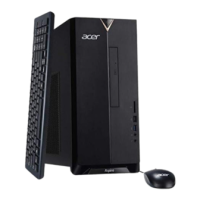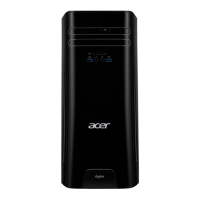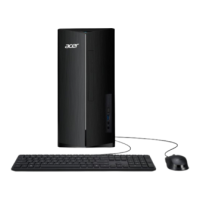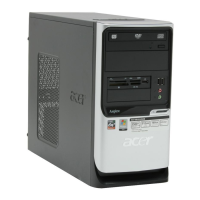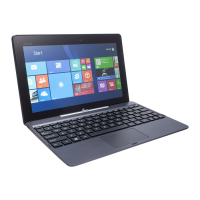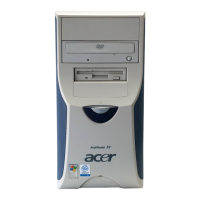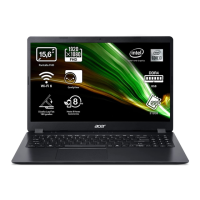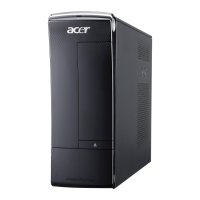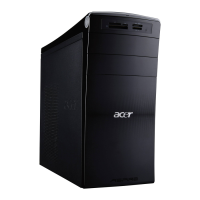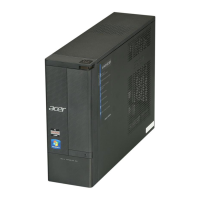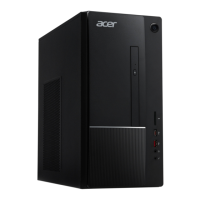
Do you have a question about the Acer Aspire TC-865 and is the answer not in the manual?
| Memory slots | 2x DIMM |
|---|---|
| Internal memory | 12 GB |
| Memory channels | Dual-channel |
| Internal memory type | DDR4-SDRAM |
| Maximum internal memory | 32 GB |
| HDD speed | 7200 RPM |
| HDD interface | SATA III |
| Storage media | HDD |
| Optical drive type | DVD±RW |
| Card reader integrated | Yes |
| Total storage capacity | 1000 GB |
| Number of storage drives installed | 1 |
| Wi-Fi standards | 802.11a, 802.11b, 802.11g, Wi-Fi 4 (802.11n), Wi-Fi 5 (802.11ac) |
| Cabling technology | 10/100/1000Base-T(X) |
| Top Wi-Fi standard | Wi-Fi 5 (802.11ac) |
| Ethernet LAN data rates | 10, 100, 1000 Mbit/s |
| Bus type | DMI3 |
| Tjunction | 100 °C |
| Processor cache | 9 MB |
| Processor cores | 6 |
| Processor model | i5-8400 |
| System bus rate | 8 GT/s |
| Processor family | Intel® Core™ i5 |
| Processor socket | LGA 1151 (Socket H4) |
| Processor codename | Coffee Lake |
| Processor frequency | 2.8 GHz |
| Processor cache type | Smart Cache |
| Processor lithography | 14 nm |
| Processor manufacturer | Intel |
| PCI Express slots version | 3.0 |
| Processor boost frequency | 4 GHz |
| Processor operating modes | 64-bit |
| ECC supported by processor | No |
| PCI Express configurations | 1x16, 1x8+2x4, 2x8 |
| Thermal Design Power (TDP) | 65 W |
| Maximum number of PCI Express lanes | 16 |
| Memory clock speeds supported by processor | 2666 MHz |
| Memory bandwidth supported by processor (max) | 41.6 GB/s |
| Maximum internal memory supported by processor | 64 GB |
| DVI port | - |
| USB 2.0 ports quantity | 4 |
| USB 3.2 Gen 1 (3.1 Gen 1) Type-A ports quantity | 2 |
| USB 3.2 Gen 1 (3.1 Gen 1) Type-C ports quantity | 0 |
| Sustainability certificates | RoHS |
| Chassis type | Desktop |
| Product color | Black |
| Placement supported | Vertical |
| Product type | PC |
| Power supply | 300 W |
| Number of execution units | 23 |
| On-board graphics card ID | 0x3E92 |
| Discrete graphics card model | Not available |
| On-board graphics card model | Intel® UHD Graphics 630 |
| On-board graphics card family | Intel® UHD Graphics |
| On-board graphics card OpenGL version | 4.5 |
| On-board graphics card base frequency | 350 MHz |
| On-board graphics card DirectX version | 12.0 |
| On-board graphics card dynamic frequency (max) | 1050 MHz |
| Number of displays supported (on-board graphics) | 3 |
| Scalability | 1S |
| Processor ARK ID | 126687 |
| Processor package size | 37.5 x 37.5 mm |
| Supported instruction sets | AVX 2.0, SSE4.1, SSE4.2 |
| Thermal solution specification | PCG 2015C |
| Intel Identity Protection Technology version | 1.00 |
| Intel Stable Image Platform Program (SIPP) version | 0.00 |
| Depth | 350 mm |
|---|---|
| Width | 163 mm |
| Height | 340 mm |
| Weight | 7400 g |
Documentation provided to assist in using your Acer desktop computer.
Essential advice for computer maintenance and safe usage.
Guidelines for proper computer maintenance and handling.
Details regarding the correct use and care of the power cord.
Procedures for cleaning the computer and when to seek professional service.
Steps to establish an internet connection using Wi-Fi.
Instructions for connecting to the internet via a network cable.
Information about the computer's integrated networking capabilities.
How to set the order of devices for booting the computer.
Procedures for enabling password protection within the BIOS.
Different types of passwords for protecting access to the computer and data.
How to input passwords when prompted by the system.
Methods and settings to reduce the computer's power consumption.
Details on the features and usage of USB 3.0 ports.
Explanation of the functions of audio jacks on the computer's rear.
Step-by-step guide for inserting memory cards into the reader.
Overview of different types and capacities of SD memory cards.
Safe procedure for ejecting memory cards from the reader.
How to connect audio devices like headphones and microphones.
Steps to resolve problems with the computer not starting or booting.
Solutions for blank screens and other display-related problems.
Steps to resolve problems with no sound output from the computer.
How to address problems with the computer's keyboard not responding.
Guide on how to reset the computer to its factory state.
Information on warranty services and how to obtain support.
Useful tips for navigating and using the Windows 10 operating system.
Steps for properly shutting down the computer.
Customizing the lock screen with images and settings.
How to adjust the display's screen resolution.
Instructions for configuring the computer as an alarm clock.
Locating and managing applications installed on the computer.
Explanation of Microsoft accounts for Windows sign-in and services.
How to find and install system updates for Windows.
Resources for additional assistance and tutorials.
General advice and strategies for resolving common computer problems.
Common error messages and their corrective actions.
Essential steps to safeguard your PC from online threats.
Guidance on selecting an ISP for internet access.
Information on connecting to the internet via a telephone line.
Details on Digital Subscriber Line internet connections.
Information about high-speed internet access via cable lines.
Connecting to the internet using cellular networks.
Understanding LAN and wireless network setups.
Role and function of access points/routers in network setup.
Description and use of RJ45 network cables for connectivity.
Information about devices that enable wireless network connectivity.
How to manage wireless network connectivity.
Information on accessing Acer's official website for support.
Overview of security programs like McAfee for PC protection.
Definition and impact of computer viruses.
Understanding spyware and its effects on computer systems.
Definition of malicious software and how to protect against it.
Explanation of personal firewalls for network security.
Importance of applying software patches and updates for security.
Details on essential security software like antivirus and firewalls.
Tips for creating and managing secure passwords.
Advice on safeguarding personal data online.
Warning about deceptive online offers and potential scams.
Importance of regularly checking financial statements for fraud.
Utilizing Windows features for computer protection.
How Windows updates enhance security and performance.
Identifying signs that your computer may be compromised.
